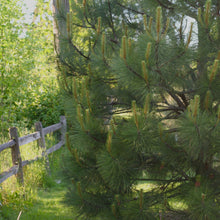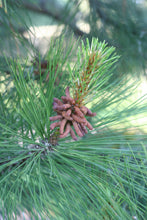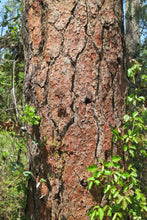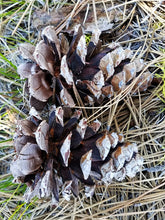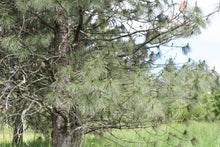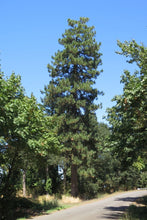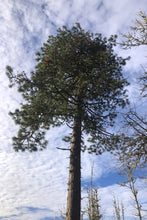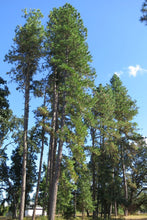
Pinus ponderosa var. benthamiana
Ponderosa pine is highly attractive to people and wildlife alike, with its broad, spreading form, and exceptionally long needles. It’s iconic bark is dark gray on young trees, then becomes cinnamon-colored and scaly over time, resembling the pieces of a jigsaw puzzle and faintly smelling of vanilla when warmed by the sun.
The Ponderosa pine trees sourced by Sparrowhawk Native Plants are from native seed sourced from the Willamette Valley (Pinus ponderosa var. benthamiana), which have been shown to be more resilient in the wet winters of the Willamette Valley versus seed sources from central Oregon (Pinus ponderosa var. ponderosa)
- Plant type/canopy layer: evergreen, perrenial, large tree
- Size at maturity: 150-200' tall, 25-30' wide
- Light requirements: full sun
- Moisture requirements: dry soil, preferably well-drained
- Bloom time: April - June
- Growth rate/ease: fast growth rate, easy to grow
- Wildlife support: Pines are extremely valuable wildlife trees, rivaling oaks. They attract and support hummingbirds, beneficial insects, pest eating insects, and countless species of birds and mammals. The nutritious, oily seeds are food for chipmunks, squirrels, crossbills, grosbeaks, jays, nuthatches, chickadees, and woodpeckers. Plus, it is a caterpillar host plant and larval food source for many species of butterflies and moths. The needles are the only known food of the caterpillars of the gelechiid moth Chionodes retiniella and are a favorite material for making nests. The foliage and bark is eaten by grouse, deer, and porcupines. Large pines provide excellent sites for roosting and nesting; small pines provide good cover for many animals.
- Native habitat/range: common on hillsides and gravelly floodplains, often mixed with oaks or other conifers from the west, from 50-1700m, from British Columbia to California and Montana to Mexico. In Oregon, we usually associate them with the eastern slope of the Cascade Mountains - but this is a Willamette Valley variety more suitable to our local ecosystem. Portland Plant List - yes.
- Special features & uses: wildlife favorite; evergreen; drought-tolerant; medicinal; landscape uses include erosion control and a windbreak; also used as a timber tree for building homes and making attractive wood furniture.
Gardening with Ponderosa Pine: Where space allows and conditions are right, this is an excellent yard tree, and particularly resilient to climate change. As it matures, it will sequester more and more carbon in its biomass each year, while intercepting stormwater from flooding the system, holding it in its evergreen canopy until it evaporates (a process called evapotranspiration). Place this majestic species in sunny areas with dry well-drained soil, especially hillsides and slopes where its wise-spread, deep root system can help stabilize the soil. This tree is exceptionally drought-tolerant, but may need infrequent but deep supplemental water during summer as it becomes established.
Photo Credit 1, 2, 5 (partial habit along fenceline, early cones): Karli Del Biondo, Beetles and Bees
Photo Credits 3, 7, 9 (bark, roadside habit, stand): © Ed Alverson, some rights reserved (CC-BY)
Photo Credit 4 (cones): © Alan Rockefeller, some rights reserved (CC-BY)
Photo Credit 8 (canopy): © Matt Benotsch, some rights reserved (CC-BY)









